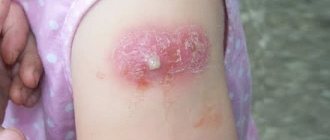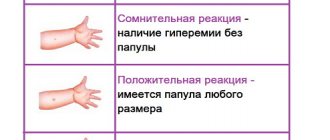BCG vaccination: what it protects against, at what age it is given
The vaccine got its name from the English abbreviation – BCG (Bacillus Calmette-Guerin). It includes a live attenuated strain of bovine tuberculosis bacillus. This bacterium is not dangerous to humans, but forms immune protection against severe forms of tuberculosis (damage to the bones of the spine, meningitis, severe damage to internal organs) and the transition of latent carriage of bacilli to an active form of infection (pulmonary tuberculosis). Source: D.T. Levi, N.V. Alexandrova Vaccinal prevention of tuberculosis // BIOpreparations. Prevention, diagnosis, treatment, 2015, p. 4-8
Today, this vaccination is given in the maternity hospital, on the 4th day of life of a full-term baby, if there are no contraindications. Premature babies are also vaccinated with BCG, but they must weigh more than 2500 g and have no health problems. Subsequently, BCG revaccination is carried out at the ages of 7 and 14 years according to the results of tuberculin tests (Mantoux).
In our country, BCG vaccination is included in the compulsory vaccination schedule of the national calendar - it is recommended for all children. But not all countries support the idea of universal vaccination against tuberculosis at an early age. Some European countries and the United States have abandoned mass vaccination; they only vaccinate children at risk. This is explained by the low incidence of tuberculosis in these countries.
Tuberculosis vaccine BCG
FSUE NPO Microgen, Ministry of Health of the Russian Federation, Russia
Release form: 1 ampoule / 20 doses No. 5.
Vaccination schedule: once on 3-7 days after birth. Revaccination at 7 and 14 years of age.
INSTRUCTIONS FOR USE of dry tuberculosis BCG vaccine
The drug is a live mycobacteria of the BCG-1 vaccine strain, lyophilized in a 1.5% solution of monosodium glutamate. The porous mass is powdery or in the form of a white or creamy tablet. Hygroscopic. The vaccination dose contains 0.05 mg in 0.1 ml of solvent. Biological and immunological properties . Live mycobacteria of the BCG-1 strain, multiplying in the body of the vaccinated person, lead to the development of long-term immunity to tuberculosis. Purpose . Active specific prevention of tuberculosis. Directions for use and dosage . The BCG vaccine is used intradermally at a dose of 0.05 mg in a volume of 0.1 ml. Primary vaccination is carried out on healthy newborn children on days 3-7 of life. Children aged 7 and 14 years who have a negative reaction to the Mantoux test with 2 TE PPD-L are subject to revaccination. The reaction is considered negative in the complete absence of infiltration, hyperemia, or in the presence of a prick reaction (1 mm). Children infected with tuberculous mycobacteria who have a negative reaction to the Mantoux test are not subject to revaccination. The interval between the Mantoux test and revaccination should be at least 3 days and no more than 2 weeks. Vaccinations should be carried out by specially trained medical personnel of the maternity hospital (ward), department for nursing premature babies, children's clinics or feldsher-obstetric stations. Vaccination of newborns is carried out in the morning in a specially designated room after the children have been examined by a pediatrician. Vaccinations at home are prohibited. In clinics, the selection of children to be vaccinated is preliminarily carried out by a doctor (paramedic) with mandatory thermometry on the day of vaccination, taking into account medical contraindications and medical history. If necessary, consultations with medical specialists and blood and urine tests are carried out. The history of the newborn (medical record) indicates the date of vaccination, series and expiration date of the vaccine, company|manufacturer. For vaccination (re-vaccination), disposable sterile tuberculin syringes with a capacity of 1.0 ml with tightly fitting pistons and thin short needles with a short bevel are used. It is prohibited to use syringes and needles that have expired and needleless injectors. After each injection, a syringe with a needle and cotton swabs are soaked in a disinfectant solution (5% chloramine) and then centrally destroyed. It is prohibited to use instruments intended for vaccination against tuberculosis for other purposes. In the vaccination room, the vaccine is stored in the refrigerator (under lock and key) and diluted. Persons unrelated to BCG vaccination are not allowed into the vaccination room. To avoid contamination, it is unacceptable to combine tuberculosis vaccination with other parenteral procedures on the same day. Vaccine ampoules are carefully inspected before opening. The drug cannot be used: - if there is no label on the ampoule or if it is filled incorrectly; - expired; — in the presence of cracks and notches on the ampoule; - when the physical properties of the drug change (wrinkled tablet, change in color, etc.); - in the presence of foreign inclusions or flakes that do not break when shaken in the diluted preparation. The dry vaccine is diluted immediately before use with a sterile 0.9% sodium chloride solution attached to the vaccine. The solvent must be transparent, colorless and free of foreign inclusions. The neck and head of the ampoule are wiped with alcohol, the sealing area (head) is filed down and carefully broken off using tweezers. Then they file and break off the neck of the ampoule, wrapping the sawed end in a sterile gauze napkin. To obtain a dose of 0.05 mg of BCG in 0.1 ml, transfer 2 ml of 0.9% sodium chloride solution into an ampoule with a 20-dose vaccine using a sterile syringe (2.0 ml capacity with a long needle), and into an ampoule with 10- dose vaccine - 1 ml of 0.9% sodium chloride solution. The vaccine should completely dissolve within 1 minute after shaking 2-3 times. Precipitation or formation of flakes that do not break when shaken is not allowed. The diluted vaccine must be protected from sunlight and daylight (for example, a cylinder of black paper) and consumed within one hour after dilution. It is mandatory to maintain a protocol indicating the time of dilution and destruction of the vaccine ampoule. Unused vaccine is destroyed by autoclaving at 126° C for 30 minutes, immersing in a disinfectant solution (5% chloramine solution) for 60 minutes or boiling for 30 minutes. For one vaccination, 0.2 ml (2 doses) of the diluted vaccine is drawn up with a sterile syringe, then 0.1 ml of the vaccine is released through a needle into a sterile cotton swab to displace the air and bring the syringe piston to the desired graduation of -0.1 ml. Before each kit, the vaccine must be carefully mixed using a syringe 2-3 times. One syringe can only administer the vaccine to one child. The BCG vaccine is administered strictly intradermally at the border of the upper and middle third of the outer surface of the left shoulder after pre-treatment of the skin with 70° alcohol. The needle is inserted with the cut upward into the surface layer of the stretched skin. First, a small amount of the vaccine is injected to make sure that the needle enters exactly intradermally, and then the entire dose of the drug (only 0.1 ml). With the correct injection technique, a whitish papule with a diameter of 7-9 mm should form, usually disappearing after 15-20 minutes. Injecting the drug under the skin is unacceptable, as this may result in the formation of a cold abscess. It is prohibited to apply a bandage or treat the vaccine injection site with iodine or other disinfectant solutions. Reaction to introduction . At the site of intradermal injection of the BCG vaccine, a specific reaction develops in the form of a papule measuring 5-10 mm in diameter. In newborns, a normal vaccination reaction appears after 4-6 weeks. The reaction undergoes reverse development within 2-3 months, sometimes over a longer period. In those revaccinated, a local reaction develops after 1-2 weeks. The site of the reaction should be protected from mechanical irritation, especially during water procedures. In 90-95% of vaccinated people, a superficial scar up to 10.0 mm in diameter should form at the vaccination site. Complications after vaccination and revaccination are rare and are usually local in nature. Contraindications . Vaccination. 1. Prematurity - birth weight less than 2500 g. 2. Acute diseases. Vaccination is postponed until the end of acute manifestations of the disease and exacerbation of chronic diseases (intrauterine infection, purulent-septic diseases, moderate and severe hemolytic disease of newborns, severe damage to the nervous system with severe neurological symptoms, generalized skin lesions, etc.). 3. Immunodeficiency state (primary), malignant neoplasms. When prescribing immunosuppressants and radiation therapy, vaccination is carried out 6 months after the end of treatment. 4. Generalized BCG infection detected in other children in the family. 5. HIV infection in the mother. Children who were not vaccinated during the neonatal period receive the BCG-M vaccine after recovery. Children aged 2 months and older are first given the Mantoux test 2TE PPD-L and only those who are tuberculin-negative are vaccinated. Other preventive vaccinations can be carried out at an interval of at least 1 month before (with the exception of vaccinations against viral hepatitis B) and after BCG vaccination. Revaccination . 1. Acute infectious and non-infectious diseases, exacerbation of chronic diseases, including allergic ones. Vaccination is carried out 1 month after recovery or remission. 2. Immunodeficiency conditions, malignant blood diseases and neoplasms. When prescribing immunosuppressants and radiation therapy, vaccination is carried out no earlier than 6 months after the end of treatment. 3. Patients with tuberculosis, persons who have had tuberculosis and are infected with mycobacteria. 4. Positive and questionable Mantoux reaction with 2 TE PPD-L. 5. Complicated reactions to the previous administration of the BCG vaccine (keloid scar, lymphadenitis, etc.). In case of contact with infectious patients in the family, child care facility, etc. Vaccinations are carried out after the end of the quarantine period or the maximum incubation period for a given disease. Other preventive vaccinations can be carried out at an interval of at least 1 month before and after BCG revaccination. Persons temporarily exempt from vaccinations must be monitored and registered, and vaccinated after full recovery or removal of contraindications. If necessary, appropriate clinical and laboratory examinations are carried out. Release form. In ampoules containing 0.5 mg (10 doses) or 1.0 mg of the drug (20 doses) complete with a solvent - 0.9% sodium chloride solution, 1 or 2 ml per ampoule, respectively. One pack contains 5 ampoules of BCG vaccine and 5 ampoules of 0.9% sodium chloride solution (5 sets). Best before date . 2 years. A drug that has expired cannot be used. Storage and transportation conditions. Store the drug at a temperature not exceeding 8° C according to SP 3.3.2.028-95. Transportation by all types of transport at a temperature not exceeding 8° C according to SP 3.3.2.028-95. Complaint . All cases of unusual post-vaccination reactions, complications and discrepancies in the physical properties of the drug must be reported to the State Research Institute for Standardization and Control of Medical Biological Preparations named after. L.A. Tarasevich (121002, Moscow, Sivtsev Vrazhek, 41; tel./fax 241-39-22) and to the address of the manufacturer who manufactured the drug. In this case, a card (of complications) is drawn up with an exact indication of the series, expiration date of the BCG vaccine and the manufacturer.
← Back
Vaccination against tuberculosis: pros and cons
Disputes regarding BCG vaccination have been going on for many years. Several questions raise doubts:
- What does the vaccine protect against ? Even full BCG vaccination does not protect against infection with tuberculosis bacteria. A child will sooner or later become infected with pathogenic mycobacteria, but they will be asymptomatically present in the lungs, not making themselves known and being contained by the immune system. The strength of the immune system and the body's reaction to these microbes are checked using Mantoux tests.
- How long does the vaccine last ? Children are recommended to strengthen their immunity at the ages of 7 and 14 years, if by this time the body has not become acquainted with mycobacteria (Mantoux test - negative). In this case, BCG revaccination is carried out, and the immune system receives an additional stimulus, renewing immune responses.
- When is the first injection given ? Many parents believe that vaccination in the maternity hospital is too early. In the first months of life, the baby has little contact with strangers and cannot get sick. But tuberculosis experts cite statistics - many adults who consider themselves healthy actually suffer from this infection, are not treated, secrete mycobacteria and can infect the baby. Among them may be grandparents, close family friends. Source: N.M. Koretskaya Tuberculosis in children and adolescents in modern conditions // Siberian Medical Review, 2010
It is known that the earlier contact with tuberculosis bacilli occurs, the higher the risk of complications of infection. Therefore, vaccination is indicated so early that the immune system has time to develop antibodies to dangerous bacilli.
Carrying out BCG: according to the calendar and individually
The vaccination is given 3-4 days after birth, only with the written consent of the parents. If a child has contraindications (temporary or permanent), he is given a medical exemption with a note on the exchange card. In the future, if there are no longer any contraindications, the child is immunized according to an individual schedule. The vaccination is done separately from all other vaccines, on a separate day. It is important to carry it out as early as possible in the first year so that the immune system begins to form.
There are two versions of the vaccine - BCG and BCG-M (the dose is halved in it). BCG-M is recommended for a weakened or low-weight child; they are vaccinated according to an individual calendar after some time.
Question answer
— Vaccination against tuberculosis - why is it needed?
— Vaccination against tuberculosis is necessary to protect a newborn from a dangerous infectious disease — tuberculosis, and its prevention. This vaccine does not protect the child from infection with mycobacteria, but it facilitates the course of the infection, preventing meningitis and the disseminated form of the disease, which often ends in the death of the baby.
In connection with not rosy epidemiological data, many are interested in the question - what is this vaccination against tuberculosis for? The fact is that the danger of primary infection with mycobacteria in children under 5 years of age lies in the imperfection of their immune system, which reacts very violently. As a result, primary contact of a child with mycobacteria can lead to the formation of meningitis or a generalized form of tuberculosis, which are very severe and almost always lead to the death of children. It is to prevent such a severe course of the disease in children that vaccination is given already in the first days of a newborn’s life. It is necessary to immunize as early as possible, since the prevalence of mycobacteria in our country is very high. In the future, vaccination against tuberculosis helps the child’s body cope with incoming mycobacteria, effectively neutralizing them and preventing the development of lung disease.
— Why are two types of vaccines BCG and BCG-M made and how do they differ?
— The BCG vaccine is used to vaccinate normal healthy, normal-weight, full-term infants. And the BCG-m vaccine contains microorganisms in a lower concentration, which is exactly half as much as BCG. This gentle BCG-m vaccine is necessary and used for vaccinating children who are underweight, anemic, weakened or premature. That is, if there are physiological contraindications for BCG vaccination, when the child simply cannot cope with the dose of antigens, a gentle vaccine, BCG-m, is used to protect the newborn from tuberculosis.
— What is the Mantoux reaction?
— A test for checking tuberculosis is called a test or Mantoux reaction. The Mantoux test is not a vaccination, since during this manipulation an immunobiological drug is not introduced that causes the development of immunity to infection; this reaction is needed to assess the strength of immunity in relation to tuberculosis. It is this reaction that is used for early diagnosis of this disease in children, instead of fluorography.
— Wouldn’t it be better to use imported BCG vaccines?
— Today, to immunize children against tuberculosis, only unified and standardized vaccine preparations are used, which are absolutely the same in all countries of the world. That is why there is no difference between tuberculosis vaccines produced in Russia or abroad.
Features of vaccination
Parents need to know where the injection is given and how the injection site then changes as immune reactions develop. The vaccine is placed in the shoulder, in its upper third, with a thin needle, and the drug is injected intradermally. Immunity is formed gradually, as an immune reaction to the introduced weakened pathogens occurs at the site of vaccination. After 6-8 weeks, a reaction occurs at the injection site: first, a nodule that rises above the surface of the skin, becoming similar to a mosquito bite; then a bubble appears in the center, which is filled with a yellow liquid. Parents think that the BCG vaccine is rotting, but this is a completely natural reaction. A crust forms, which then flies off, leaving a scar.
But why does the scar remain and is it possible to avoid such a reaction? Doctors say this is a normal immune process and the grafted area remains virtually invisible over time. To keep the scar small, you do not need to touch the sore, rip off the scab, or smear it with brilliant green or iodine.
Are parents concerned about whether it is possible to bathe their child when a blister and crust appear? All hygiene procedures are carried out as usual, but the vaccination site does not need to be vigorously rubbed, just gently washed with soap and water.
Contraindications for carrying out
As with any vaccination, there are contraindications for BCG. These include body weight less than 2500 g, severe trauma during childbirth, hemolytic disease of the newborn and general infectious pathologies. For revaccination at the ages of 7 and 14 years, the contraindications are as follows:
- previous tuberculosis or bacterial infection;
- positive Mantoux test;
- high temperature, ARVI and any acute diseases;
- oncological diseases;
- previous complications from vaccination. Source: N.V. Krivokhizh Methods of preventing tuberculosis among children and adolescents // Health is the basis of human potential: problems and solutions, 2013, p. 585-602
Complications after vaccination
BCG is well tolerated, complications after vaccination rarely occur. If the vaccine was administered subcutaneously rather than intradermally, an abscess may develop in the tissues. There is cyanosis of the skin, a pea-sized formation and reactions of the lymph nodes. It is important to pay attention to the dynamics of the process and report this to the pediatrician.
Sources:
- D.T. Levi, N.V. Alexandrova. Vaccinal prevention of tuberculosis // Biopreparations. Prevention, diagnosis, treatment, 2015, p. 4-8.
- N.M. Koretskaya. Tuberculosis in children and adolescents in modern conditions // Siberian Medical Review, 2010.
- N.V. Krivokhizh Methods of preventing tuberculosis among children and adolescents // Health is the basis of human potential: problems and solutions, 2013, p. 585-602.
The BCG vaccine is given only in maternity hospitals.
Children's medical does not vaccinate with BCG.
REACTIONS AND COMPLICATIONS DURING VACCINATION
In practice, most post-vaccination reactions are individual in nature and cannot be predicted. Most often, quite predictable mild reactions are observed at the injection site, expressed in swelling and redness of the shoulder and an increase in body temperature to subfebrile levels. Many of these reactions are caused by aseptic inflammation, often due to injection of the vaccine into the subcutaneous fat (especially when vaccinating obese individuals with a short needle). Such reactions go away on their own in a couple of days, and if you take paracetamol, then even faster. Sometimes there is an increase in regional lymph nodes - and this is also a normal reaction to the vaccine.
© ROBIN UTRECHT/AFP/Getty Images
The second most common reaction to vaccination is fainting. Often, from the very sight of the syringe or a few minutes after the injection, vaccine recipients lose consciousness, which is often accompanied by convulsions and vomiting. This reaction is of the same nature as fainting at the sight of blood. It is not related to the vaccine as such, but for an outsider, as well as for the person being vaccinated, such a reaction is very unpleasant. True allergic reactions to vaccine components are relatively rare, but after vaccination the patient should be monitored for an hour in order to react in time to possible anaphylaxis. Before receiving the vaccine, the patient must be asked about his allergies to the components of the vaccine (chicken protein in the influenza vaccine, baker's yeast in the hepatitis B vaccine, etc.).
It should be noted that the presence of contraindications does not mean that the vaccine recipient will inevitably experience a complication. However, contraindications protect the medical worker from possible legal consequences... A clever lawyer can prove to a judge, far from practical medicine, the connection between vaccination and a complication of pregnancy or the birth of a defective child. Therefore, pregnant women are not vaccinated against rubella, mumps, measles, chickenpox and BCG. But non-live anti-influenza vaccines began to be strongly recommended for pregnant women after the swine flu pandemic...










